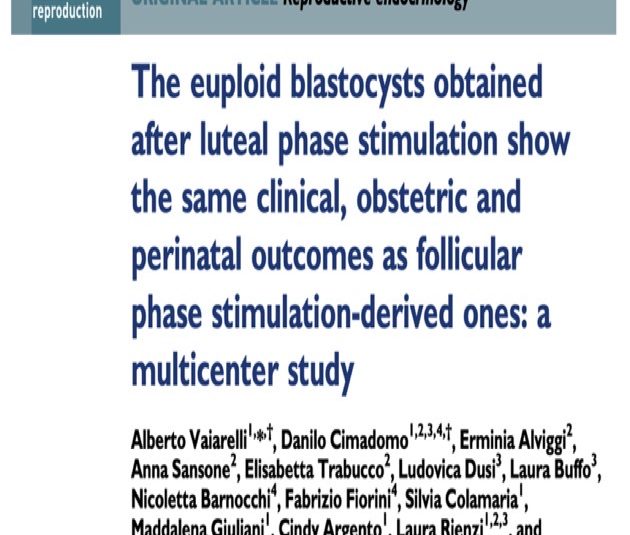
The euploid blastocysts obtained after luteal phase stimulation show the same clinical, obstetric and perinatal outcomes as follicular phase stimulation-derived ones: a multicenter study
Alberto Vaiarelli, Danilo Cimadomo, Erminia Alviggi, Anna Sansone, Elisabetta Trabucco, Ludovica Dusi, Laura Buffo, Nicoletta Barnocchi, Fabrizio Fiorini, Silvia Colamaria, Maddalena Giuliani, Cindy Argento, Laura Rienzi, and Filippo Maria Ubaldi
Human Reproduction, Vol.00, No.0, pp. 1–11, 2020 doi:10.1093/humrep/deaa203 – Submitted on April 6, 2020; resubmitted on July 13, 2020; editorial decision on July 22, 2020 – Published: 20 September 2020
Abstract
STUDY QUESTION: Are the reproductive outcomes (clinical, obstetric and perinatal) different between follicular phase stimulation (FPS)- and luteal phase stimulation (LPS)-derived euploid blastocysts?
SUMMARY ANSWER: No difference was observed between FPS- and LPS-derived euploid blastocysts after vitrified-warmed single em- bryo transfer (SET).
WHAT IS KNOWN ALREADY: Technical improvements in IVF allow the implementation non-conventional controlled ovarian stimula- tion (COS) protocols for oncologic and poor prognosis patients. One of these protocols begins LPS 5 days after FPS is ended (DuoStim). Although, several studies have reported similar embryological outcomes (e.g. fertilization, blastulation, euploidy) between FPS- and LPS- derived cohort of oocytes, information on the reproductive (clinical, obstetric and perinatal) outcomes of LPS-derived blastocysts is limited to small and retrospective studies.
STUDY DESIGN, SIZE, DURATION: Multicenter study conducted between October 2015 and March 2019 including all vitrified- warmed euploid single blastocyst transfers after DuoStim. Only first transfers of good quality blastocysts (BB according to Gardner and Schoolcraft’s classification) were included. If euploid blastocysts obtained after both FPS and LPS were available the embryo to transfer was chosen blindly. The primary outcome was the live birth rate (LBR) per vitrified-warmed single euploid blastocyst transfer in the two groups. To achieve 80% power (a 1⁄4 0.05) to rule-out a 15% difference in the LBR, a total of 366 first transfers were required. Every other clinical, as well as obstetric and perinatal outcomes, were recorded.
PARTICIPANTS/MATERIALS, SETTING, METHODS: Throughout the study period, 827 patients concluded a DuoStim cycle and among them, 339 did not identify any transferable blastocyst, 145 had an euploid blastocyst after FPS, 186 after LPS and 157 after both FPS and LPS. Fifty transfers of poor quality euploid blastocysts were excluded and 49 patients did not undergo an embryo transfer during the study period. Thus, 389 patients had a vitrified-warmed SET of a good quality euploid blastocyst (182 after FPS and 207 after LPS). For 126 cases (32%) where both FPS- and LPS-derived good quality blastocysts were available, the embryo transferred was chosen blindly with a ‘True Random Number Generator’ function where ‘0’ stood for FPS-derived euploid blastocysts and ‘1’ for LPS-derived ones (n1⁄470 and 56, respectively) on the website random.org. All embryos were obtained with the same ovarian stimulation protocol in FPS and LPS (GnRH antagonist protocol with fixed dose of rec-FSH plus rec-LH and GnRH-agonist trigger), culture conditions (continuous culture in a humidified atmosphere with 37 C, 6% CO2 and 5% O2) and laboratory protocols (ICSI, trophectoderm biopsy in Day 5–7 without assisted hatching in Day 3, vitrification and comprehensive chromosome testing). The women whose embryos were included had similar age (FPS: 38.5 § 3.1 and LPS: 38.5 § 3.2 years), prevalence of male factor, antral follicle count, basal hormonal characteristics, main cause of infertility and previous reproductive history (i.e. previous live births, miscarriages and implantation failures) whether the embryo came from FPS or LPS. All transfers were conducted after warming in an artificial cycle. The blastocysts transferred after FPS and LPS were similar in terms of day of full-development and morphological quality.
MAIN RESULTS AND THE ROLE OF CHANCE: The positive pregnancy test rates for FPS- and LPS-derived euploid blastocysts were 57% and 62%, biochemical pregnancy loss rates were 10% and 8%, miscarriage rates were 15% and 14% and LBRs were 44% (n 1⁄4 80/182, 95% CI 37–51%) and 49% (n1⁄4102/207, 95% CI 42–56%; P1⁄40.3), respectively. The overall odds ratio for live birth (LPS vs FPS (reference)) adjusted for day of blastocyst development and quality, was 1.3, 95% CI 0.8–2.0, P1⁄40.2. Among patients with euploid blastocysts obtained following both FPS and LPS, the LBRs were also similar (53% (n 1⁄4 37/70, 95% CI 41–65%) and 48% (n 1⁄4 27/56, 95% CI 35–62%) respectively; P1⁄40.7). Gestational issues were experienced by 7.5% of pregnant women after FPS- and 10% of women following LPS-derived euploid single blastocyst transfer. Perinatal issues were reported in 5% and 0% of the FPS- and LPS-derived newborns, respectively. The gestational weeks and birthweight were similar in the two groups. A 5% pre-term delivery rate was reported in both groups. A low birthweight was registered in 2.5% and 5% of the newborns, while 4% and 7% showed high birthweight, in FPS- and LPS-derived euploid blastocyst, respectively. Encompassing the 81 FPS-derived newborns, a total of 9% were small and 11% large for gestational age. Among the 102 LPS-derived newborns, 8% were small and 6% large for gestational age. No significant difference was reported for all these comparisons.
LIMITATIONS, REASONS FOR CAUTION: The LPS-derived blastocysts were all obtained after FPS in a DuoStim protocol. Therefore, studies are required with LPS-only, late-FPS and random start approaches. The study is powered to assess differences in the LBR per embryo transfer, therefore obstetric and perinatal outcomes should be considered observational. Although prospective, the study was not registered.
WIDER IMPLICATIONS OF THE FINDINGS: This study represents a further backing of the safety of non-conventional COS protocols. Therefore, LPS after FPS (DuoStim protocol) is confirmed a feasible and efficient approach also from clinical, obstetric and perinatal perspectives, targeted at patients who need to reach the transfer of an euploid blastocyst in the shortest timeframe possible due to reasons such as cancer, advanced maternal age and/or reduced ovarian reserve and poor ovarian response.
STUDY FUNDING/COMPETING INTEREST(S): None. TRIAL REGISTRATION NUMBER: N/A.
Key words: luteal phase stimulation / DuoStim / euploid blastocyst / clinical outcomes / obstetric outcomes / perinatal outcomes
